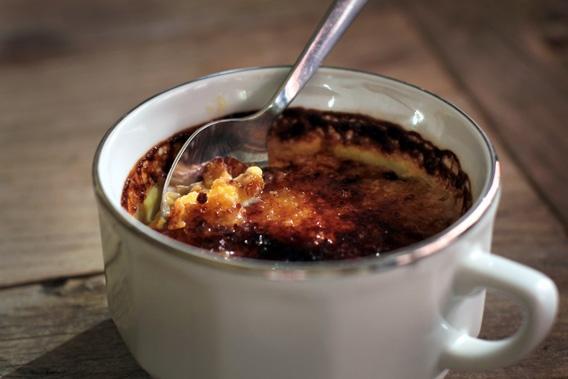During my Mexican-food-obsessed youth, my favorite dessert was flan, the Latin American version of crème caramel: smooth, eggy custard enveloped in browned sugar syrup. That was until I tried crème brûlée, which is nearly identical to crème caramel, with one crucial difference: Instead of being melted into syrup, the sugar is sprinkled on top of the custard and burnt to a crisp. (The name literally means “burned cream,” which elides some nuance but gets the point across.)
Both desserts combine a bland but very rich custard with some cloying variation on pure sugar. Custard and sugar, by themselves, are boring; together, they make a well balanced dessert. (In terms of flavor, not nutrition, obviously.) But unlike crème caramel, crème brûlée provides an irresistible textural contrast between silky custard and crunchy sugar.
What’s more, the charred flavors that burning creates add a soupçon of dark sophistication utterly lacking in crème caramel. Extend the implications of burning into the metaphorical realm, and you begin to understand why crème brûlée is a favorite among would-be seducers and seductresses: the flames of passion made literal, the naughty danger of fire made edible, etc. (There’s symbolic satisfaction for cynical singles in crème brûlée, too—in the bitter flavor that emerges when you scorch sugar granules.)
In other words, crème brûlée is the ne plus ultra of Valentine’s Day desserts. And though it requires only ingredients you probably already have in your fridge, it is 1) insanely easy to make (you can even do most of it a few days ahead of time, if necessary); 2) pretty much impossible to screw up (I mean, you’re supposed to burn it); and 3) virtually guaranteed to garner admiration from your Valentine (or your cats, as the case may be).
The most challenging part of making crème brûlée is putting the custard in the oven to bake. I’m not being entirely facetious—it’s actually a little tricky. That’s because you must cook the custard (a thin batter of cream, egg yolks, and sugar) in a water bath; surrounding the ramekins with hot water keeps the custard moist and prevents it from breaking into a lumpy, curdled mess. Assemble the contraption on top of your oven, or on a nearby countertop, so you don’t have to carry it far and risk spilling the custard mixture, or the boiling water, or both.
Once steamed in the water bath, the custard will taste as smooth and velvety as the voice of Bobby “Blue” Bland, though by itself it is as flavorful as his surname. It will also appear quite homely, its surface covered with pockmarks. The burned sugar layer takes care of both of these problems, but does require additional care to create. Using the right amount of sugar is crucial. It should coat the entire surface of each custard—no patches of yellow should peek through—but it should not be so thick that it piles into shallow ridges or mounds on top of the custard. Once burnt, the sugar should audibly crack when you hit it with a spoon; if there’s too little sugar, it won’t melt into a solid crust, but if there’s too much it’ll overwhelm the custard with its burnt flavor and adhere unpleasantly to your teeth. (Take note that only granulated sugar should be used to top crème brûlée; large-grained turbinado or demerara sugar and moist brown sugar will never achieve the sheen and crisp texture you’re going for.) As for technique, broiling in the oven is the most pragmatic option for most, though it gives you less control over the process than using a culinary blowtorch. If you do go the broiling route, keep a close eye on the ramekins and consider rotating them once or twice to help the sugar caramelize evenly.
Vanilla is the only flavor traditionally added to crème brûlée, and if you want to go the ultra-traditionalist (and costly) route, you can add a split vanilla bean to your saucepan of cream, steep it for 10 minutes, and then discard the pod before proceeding. I like vanilla extract just fine—but only when it’s supplemented with a glug of Grand Marnier. Burnt sugar and orange complement each other too perfectly to pass up the opportunity to combine them.
Crème Brûlée
Yield: 4 servings
Time: 3 hours, almost entirely unattended
2 cups heavy cream
6 large egg yolks
½ cup plus 8 teaspoons sugar
1 tablespoon Grand Marnier
½ teaspoon vanilla extract
1. Heat the oven to 300°F, and bring a kettle of water to a boil. Put four 8-ounce ramekins in a 9- by 13-inch pan.
2. Put the cream in a medium saucepan over medium-low heat and cook until it begins to steam, about 5 minutes. Meanwhile, put the egg yolks and ½ cup sugar in a large bowl and whisk until the mixture is pale yellow and silky, about 1 minute. Whisk in the Grand Marnier and vanilla.
3. Gradually add the hot cream to the egg mixture, whisking constantly. Pour the custard mixture into the ramekins. Add enough boiling water to the 9- by 13-inch pan to come about halfway up the sides of the ramekins, then cover the pan with foil and transfer it carefully to the oven. Bake until the custard no longer appears liquid in the center, 45 to 50 minutes. Remove the ramekins from the pan and cool for at least 1 hour at room temperature, then cover each ramekin with foil or plastic wrap and refrigerate for at least 1 hour and up to a few days.
4. Heat the broiler. Sprinkle 2 teaspoons sugar over the top of each custard and broil until the sugar is melted and deeply browned, 3 to 5 minutes. (Or, instead of broiling, you can caramelize the sugar with a culinary blowtorch.) Serve.
Previously in You’re Doing It Wrong:
Crabby Snacks and Homemades
Banana Bread
Hot Chocolate
Gingerbread Cookies
Banana Pudding
Lemon Bars
Brownies
